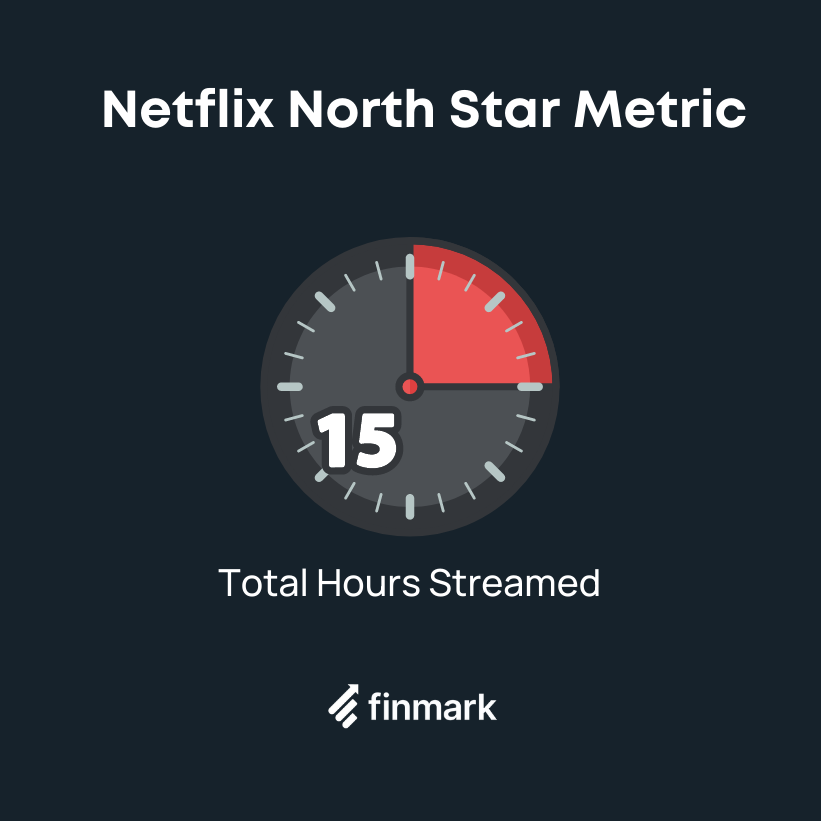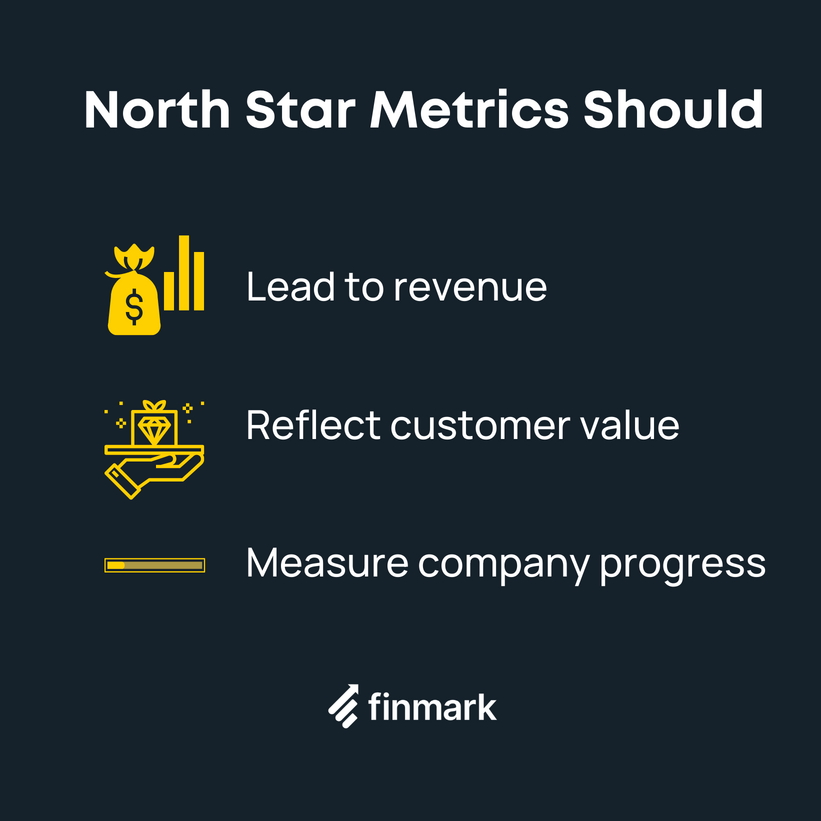How to Find Your North Star Metric (80+ Examples)

The North Star metric framework helps companies get past the surface level of their product and put a more defined focus on long-term scalable growth.
But instead, many early-stage founders look past this critical step and only focus on revenue. A North Star metric is uncovered by digging deep enough to thoroughly understand the value your customers get from using your product.
Once you can identify the value your product provides, you need to figure out the best way to quantify this value into a single, measurable metric. Some of the most notable examples include active users or hours streamed.
This guide is designed to help you find your own unique North Star metric using a straightforward approach that perfectly suits your business.
What Is a North Star Metric (NSM)?
A North Star metric provides your business with a concrete way to measure growth within the organization.
Your NSM should:
- Be easy to measure
- Have a high correlation with success
- Have clear communication with the company’s strategy
- Provide an objective view on the performance of the company
The best way to think about a North Star metric is as a top-line metric that aligns with the long-term vision of your company. By becoming hyper-focused on your NSM, you can create clarity within your organization for future optimizations.
Your NSM will also track the impact and progress you are making as an organization. By seeing this growth in an easy-to-measure way, you can hold your team accountable for the outcomes that are being produced.
However, becoming overly obsessed with your metric can be dangerous too. This can cause you to ignore the short-term and skip over potential new opportunities.
Maintaining an open-ended approach as a team will allow you to continue to work towards the growth of your North Star metric without risking short-term growth.
Why You Need A North Star Metric
A North Star metric absolutely needs to be included in your foundational plans. This is where you consider everything important before product launches, hiring, etc.
North Star metrics provide plenty of benefits for the future of your company and the growth you can tap into, especially as an early-stage startup. Most notably, it delivers a singular focus for your team to always be working towards.
By narrowing your focus, you can align your entire team to see things through one lens. This creates clarity within your organization and removes any external noise that could pull you in a different direction.
Another benefit to a well-defined NSM is the direct impact it has on growth and revenue. If you are seeing your NSM grow, but revenue isn’t following along then something is clearly wrong. This will allow you to step back and identify the issue.
The key is to view a North Star metric as an output value. For example, if Netflix wants to increase the total amount of hours streamed they need to determine what input values could drive growth to increase total streaming.
By knowing the output value first, you can strategize better ways to create effective input values. For Netflix, they want to bring users back to the platform more often and once they get to the platform they want to keep them there longer. One way Netflix does this is through the creation of original content.
From a single North Star metric, you can create an entire business strategy that causes an explosion of growth for years to come.
What Is a Good North Star Metric?
Not every metric or KPI is a good North Star metric. Before you get started, lay out the vision of your product and how you hope to serve your customers. Start with what exactly your product does and work from there.
Once you have outlined the vision of your company, it is time to start thinking about potential North Star metrics that could define your future.
For example, Netflix uses the total hours streamed by users as their NSM. This gives them an in-depth look at how users are interacting with their platform, it’s measurable, and it’s a good indicator of success (if more people are watching content, it means they’re getting value from Netflix).

If you aren’t convinced about the importance of an NSM, consider MySpace. Many people involved with MySpace, including Buckley Barlow, believe that the key reason why they failed and Facebook succeeded was a North Star metric.
MySpace focused on using a broad metric like total Registered Users while Facebook opted to track Monthly Active Users. Instead of tracking consistent interaction with the platform, they only focused on adding new members rather than cultivating relationships with existing ones.
80+ North Star Metric Examples
👉 We’ve compiled over 80 North Star metrics from businesses of various industries, sizes, and stages. See the full list here!
There are really endless numbers of North Star metric examples because they are specifically developed to fit one unique business.
For example, Roku is a leader in the world of streaming and they continue to produce original content of their own and develop partnerships with other streaming giants. They monetize the platform primarily through advertisements on free content. The North Star metric Roku uses to track growth is Average Revenue Per User (ARPU).
ARPU allows Roku to focus on the way they are monetizing users based on interactions with their free content, rather than getting lost in the notion that the only thing they should focus on is user growth.
If Roku can continue to grow ARPU, hours streamed or total users becomes less important because they know they already have a devoted customer base that they can keep monetizing with better content or improved ad targeting.
Here is a look at some notable NSMs for major industries.
E-commerce North Star Metrics
- Customer Lifetime Value (CLV)
- Percentage of Repeat Purchases
- Number of Purchasers Per Month
SaaS North Star Metrics
- Retention
- Customer Interactions
- Number of Paid Users
Tech North Star Metrics
- Number of Actions Taken Per User
- Daily Active Users (DAUs)
- Monthly Active Users (MAUs)
Media North Star Metrics
- Total Hours Streamed
- Average Revenue Per User (ARPU)
- Time Spent Listening
Here is a look at some of the bigger companies in the world and their own North Star metrics that they have used to reach immense levels of growth. (Check out the full list of 80+ North Star metrics).
| Company | North Star Metric |
| Intercom | Number of Customer Interactions |
| Salesforce | Average Records Created Per Account |
| Walmart | Purchases Per Customer Session |
| Zoom | Weekly Hosted Meetings |
| Medium | Total Time Spent Reading |
| Twilio | Total Messages Sent |
| DocuSign | Number Of Documents Signed |
| Spotify | Monthly Paid Subscribers |
| Airbnb | Nights Booked |
| Uber | Number Of Trips |
| Daily Active People | |
| Slack | Number of Paid Teams |
| DropBox | Teams Using Dropbox |
Intercom’s North Star Metric
Intercom is a B2B messaging platform where customers and companies can interact with each other. This conversational relationship platform allows businesses to provide more personalized support and engagement with their clients.
By tracking the number of customer interactions, Intercom lives up to its mission “to help businesses build better customer relationships through personalized, messenger-based experiences.”
Salesforce’s North Star Metric
Salesforce is the most famous CRM in the world with plenty of advanced features to power businesses across the world to sell better. They also use one of the most unique North Star metrics by tracking the average records created per account.
This aligns with what Salesforce aims to do by bringing together people through technology. As a Salesforce user, the first thing you do with the software after interacting with a new contact is create a record.
The value in the record is storing their information, building a stronger database, and staying in touch with potential new customers. By tracking new records, Salesforce can see exactly how often users are finding new customers.
Walmart’s North Star Metric
Walmart is a retail giant operating in the e-commerce space so they are focusing on growth with a transaction-based North Star metric. They track the purchases per customer session to get an idea of their customer loyalty and LTV per customer.
By tracking the total purchases by a customer, Walmart can avoid getting caught up on total purchase value and following the wrong metric. Instead, the frequency of the activity gives them a better glimpse into how well they are growing.
Zoom’s North Star Metric
Zoom’s North Star metric is weekly hosted meetings and fits flawlessly with their vision to empower people through video communications. Zoom understands that the frequency of meetings is a better way to gauge their performance instead of a vanity metric like signups.
Medium’s North Star Metric
The objective of Medium is to redefine the way creators think of digital publishing. The platform gives a new way for readers to find content and publishers to interact with potential readers. This is why Medium focuses on the total time spent reading as their NSM.
If they decided to only focus on paid accounts, they would misinterpret how well the platform is performing because of the amount of access free users have too. The time spent reading is a more accurate representation of how well the Medium platform is performing and growing.
Twilio’s North Star Metric
Twilio aims to empower the world of business communications by democratizing communications channels. When you consider this vision alongside the North Star metric to track total messages sent, it is clear they have tapped into the key to growth moving forward.
DocuSign’s North Star Metric
DocuSign has revolutionized the way business is done across the world. The mission of DocuSign is to eliminate the need for paper documents and empower users anywhere to sign documents with streamlined processes. Of course, they track this with their North Star metric of the number of documents signed.
Spotify’s North Star Metric
Spotify uses three North Star metrics to measure different business goals:
- Number of paid subscribers (an important revenue metric)
- Podcast consumption hours (a great engagement metric and an insight into how that arm of the app is performing specifically
- Monthly active users (a classic NSM for freemium apps)
Airbnb’s North Star Metric
Airbnb’s goal is to disrupt the hotel industry and be the go-to app for booking holiday accommodation.
This comes both through the acquisition of new customers, and by having existing customers continue to book more trips with Airbnb. As such, their NSM “night’s booked” is the perfect guiding metric.
Uber’s North Star Metric
Uber is an interesting case, as they really have two types of customers: riders and drivers.
Rather than set up individual North Star metrics for each goal, however, Uber has kept things super simple by identifying the single measurement that unites the two: Number of Trips.
Additionally, they track market share as a competitive metric and gross billings as a high-level revenue measurement.
Instagram’s North Star Metric
Instagram’s primary goal is clear: get as many eyes on the app as possible (and ideally multiple times per day).
Their NSM, Daily Active People is the perfect reflection of this, and an ideal example of how simple a good North Star can be.
Slack’s North Star Metric
Slack tracks two NSMs: number of paid teams and number of “successful” teams.
While it’s not exactly clear what a “successful” team is to Slack (one assumes they have some pretty clear criteria for this), their other North Star metrics reveals what’s important to Slack: converting free users into paid plans.
Dropbox’s North Star Metric
Dropbox’s NSM (Teams Using Dropbox) is uniquely aligned with their mission: online storage for enterprise companies (rather than being a largely-consumer facing solution like Google Drive).
How To Choose Your North Star Metric
The type of revenue model your company uses and the niche you operate in will play a major role in the selection of your NSM. Typically, these are the two most important factors that will impact how you should measure growth.
You should also consider the different financial metrics that you’re already tracking when deciding on the best North Star metric for your business. For example, knowing things like churn rate and CLV already will be a significant help to narrow down your NSM.
When breaking down the process to determine your NSM, consider if it leads to revenue, reflects customer value, and measures company progress.

There are five critical steps to take to decide on the perfect North Star metric for your business.
1. Define Your Customer’s Success Moment
The success moment is the outcome of your NSM. This is defined perfectly in the gig economy for organizations like Lyft. When a ride is booked for both the rider and driver, there is a delivery of success and both parties receive an outcome.
This is why Lyft tracks the number of rides per week as their very own North Star metric. Others in this marketplace space focus on the volume of transactions during a specific time period as a reliable NSM.
2. Can You Measure This Success Moment?
The metric needs to be measurable to qualify as a North Star metric. Remove any abstract thoughts or ideas of how you want customers to view your product because they won’t work here.
Beyond just measurability, it should also be easily communicable to your team. It is extremely important to remove any gray area from your North Star metric so that everybody on your team understands the vision.
3. You Can Define A Time Range With Enough Frequency
Every North Star metric should have a time period or level of frequency that determines how often you are measuring growth. This could be daily, weekly, or monthly, and includes metrics like MAUs, weekly meetings hosted, etc.
By choosing a metric with a frequency, analyzing growth becomes straightforward and allows your team to follow along too.
4. You Have Control Over This Metric
This is arguably the most important part of every NSM. If you have no control over the metric you choose, you will be stuck running around in circles.
For example, if Salesforce decided to track a metric related to closed deals instead of usage within the platform they would lose complete control over their metric. They cannot measure their own success based on how well their users sell. But they can measure it based on platform engagement.
5. If This Metric Grows, Your Business Will Grow
Lastly, your metric needs to drive future growth. This is why it is important to avoid vanity metrics like MySpace did, and focus on a metric that will directly impact the future growth of revenue and customer retention.
North Star Metric Cheat Sheet
The best path forward for identifying the North Star metric that properly aligns with your business growth goals is to follow the steps outlined above.
That said, it’s always nice to have a reference point to start from.
So, if you’re still feeling a little lost as to what a suitable NSM might be for your organization, here’s a quick cheat sheet on the most commonly used metrics for different business models.
| Business Models | Popular North Star metrics | Examples of companies using these NSMs |
| Freemium | MAU, free to paid conversion rate, revenue growth | Spotify, Tinder, Duolingo |
| Enterprise SaaS | MAU/WAU/DAU, number of paid teams | Slack, Asana, Airtable, DropBox, HubSpoT |
| Ads and user generated content | MAU, time on site, average sessions length | Instagram, YouTube, Facebook, Quora |
| Ecommerce | Average order value, repeat customer rate | Amazon, Flipkart, eBay |
Find Your North Star Metric
Getting started with a North Star metric requires a firm grasp of your financial and analytic reporting processes. Without reliable data, it becomes difficult to properly execute the North Star metric strategy.
Finmark allows you to manage and track all of your key financial metrics in one place so you can implement growth strategies seamlessly to grow revenue with your NSM in mind. Sign up for a free 30-day trial today!
Contributor
This content is presented “as is,” and is not intended to provide tax, legal or financial advice. Please consult your advisor with any questions.
